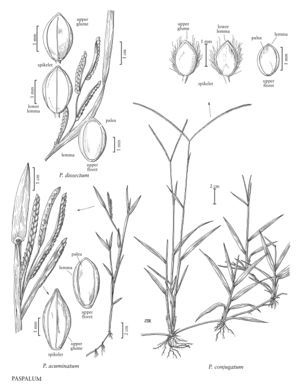Difference between revisions of "Paspalum dissectum"
FNA>Volume Importer |
imported>Volume Importer |
||
| (4 intermediate revisions by 2 users not shown) | |||
| Line 16: | Line 16: | ||
-->{{Treatment/Body | -->{{Treatment/Body | ||
| − | |distribution=Md.;N.J.;Tenn.;Okla.;Miss.;Tex.;La.;Mo.;Del.;Ala.;D.C;Kans.;N.C.;S.C.;Va.;Ark.;Ill.;Ga.;Ky.;Fla. | + | |distribution=Md.;N.J.;Tenn.;Okla.;Miss.;Tex.;La.;Mo.;Del.;Ala.;D.C.;Kans.;N.C.;S.C.;Va.;Ark.;Ill.;Ga.;Ky.;Fla. |
| − | |discussion=<p>Paspalum dissectum grows at the edges of lakes, ponds, rice fields, and wet roadside ditches. It is native to the eastern portion of the contiguous United States and to Cuba.</p> | + | |discussion=<p><i>Paspalum dissectum</i> grows at the edges of lakes, ponds, rice fields, and wet roadside ditches. It is native to the eastern portion of the contiguous United States and to Cuba.</p> |
|tables= | |tables= | ||
|references= | |references= | ||
| Line 26: | Line 26: | ||
-->{{#Taxon: | -->{{#Taxon: | ||
name=Paspalum dissectum | name=Paspalum dissectum | ||
| − | |||
|authority=(L.) L. | |authority=(L.) L. | ||
|rank=species | |rank=species | ||
| Line 33: | Line 32: | ||
|basionyms= | |basionyms= | ||
|family=Poaceae | |family=Poaceae | ||
| − | |illustrator=Linda A. Vorobik | + | |illustrator=Linda A. Vorobik;Cindy Roché |
| − | |distribution=Md.;N.J.;Tenn.;Okla.;Miss.;Tex.;La.;Mo.;Del.;Ala.;D.C;Kans.;N.C.;S.C.;Va.;Ark.;Ill.;Ga.;Ky.;Fla. | + | |illustration copyright=Utah State University |
| + | |distribution=Md.;N.J.;Tenn.;Okla.;Miss.;Tex.;La.;Mo.;Del.;Ala.;D.C.;Kans.;N.C.;S.C.;Va.;Ark.;Ill.;Ga.;Ky.;Fla. | ||
|reference=None | |reference=None | ||
|publication title= | |publication title= | ||
|publication year= | |publication year= | ||
|special status= | |special status= | ||
| − | |source xml=https:// | + | |source xml=https://bitbucket.org/aafc-mbb/fna-data-curation/src/200273ad09963decb8fc72550212de541d86569d/coarse_grained_fna_xml/V25/V25_1445.xml |
|subfamily=Poaceae subfam. Panicoideae | |subfamily=Poaceae subfam. Panicoideae | ||
|tribe=Poaceae tribe Paniceae | |tribe=Poaceae tribe Paniceae | ||
Latest revision as of 17:57, 11 May 2021
Plants perennial; rhizomatous. Culms 10-50 cm, decumbent; nodes glabrous or pubescent. Sheaths glabrous; ligules 2-2.5 mm; blades to 12 cm long, 1.3-4.8 mm wide, flat. Panicles terminal, with 2-6 racemosely arranged branches; branches 1.3-5.3 cm, diverging to erect, often arcuate, persistent; branch axes 1.8-3 mm wide, broadly winged, usually conduplicate, glabrous, margins scabrous, terminating in a spikelet. Spikelets 1.7-2.1 mm long, 1.1-1.4 mm wide, solitary, appressed to the branch axes, elliptic to ovate, glabrous, stramineous. Lower glumes absent; upper glumes and lower lemmas 5-veined; upper florets stramineous, lemmas glabrous throughout. Caryopses 1-1.3 mm, white. 2n = 40, 60.
Distribution
Md., N.J., Tenn., Okla., Miss., Tex., La., Mo., Del., Ala., D.C., Kans., N.C., S.C., Va., Ark., Ill., Ga., Ky., Fla.
Discussion
Paspalum dissectum grows at the edges of lakes, ponds, rice fields, and wet roadside ditches. It is native to the eastern portion of the contiguous United States and to Cuba.
Selected References
None.
